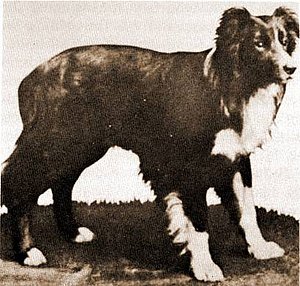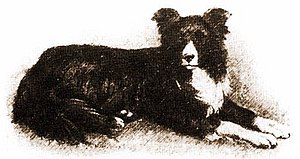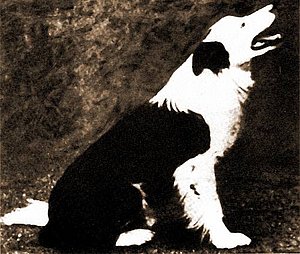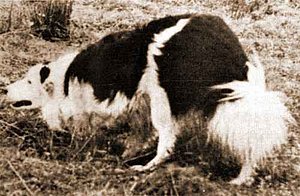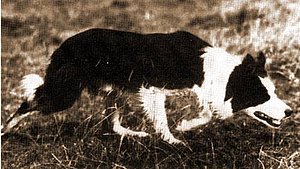The origin of the breed lies in some dogs with a still visible influence. Several important characteristics of these dogs can be found in the current Border Collies.
A disadvantage of this narrow basis is of course that bad characteristics, like hereditary properties can be embedded in the breed. Particularly in the early days, working ability was the main selection criterion, while no attention was put on health, apart from the dogs having to be able to handle the work at the farm.
Old Hemp
This dog (born in 1893) served as the model for the Border Collie exterior. His big influence on the breed was caused by his sensational appearance at trials. Since he started trials at the age of one, he never lost one. Old Hemp had a formidable ability to read sheep, and finished every course apparently without any difficulty. The reticent Scots apparently described him as 'bluidy marvellous'.
Actually, it was quite surprising that Old Hemp was this talented. His father—Roy—was a nice dog, but did not posses special talent for herding sheep. His mother—Meg—on the contrary was such an intense worker that she hypnotised herself instead of the sheep. Thus Old Hemp was a typical example of a dog inheriting all the good characteristics of its parents without being burdened by their bad habits.
During the eight years of his life, Old Hemp was a very popular stud dog, supposedly he fathered more than 200 dogs and an unknown number of bitches. A scary high number of offspring, and thus most current Border Collies are somehow descendants of Old Hemp. A factor adding to the success of Old Hemp as stud dog is the fact he passed on his characteristics to his offspring very well. Many of them became successful trial dogs.
Old Kep
In the year Old Hemp died (1901), Old Kep saw the first light of day. One of his contributions to the breed was his kind nature. While the first Borders were a little averse of strangers, Old Kep was the kindest dog.
The genes of Old Kep ended up in the breed through amongst others Herdman's Tommy (ISDS 16), a grandson of Old Hemp. Don (ISDS 11)—a son of Old Kep—was exported to New Zealand where he contributed greatly to the Australian Border Collies.
Another contribution of Old Kep to the breed was his 'eye'. His ability to control the sheep with his look resulted in 45 first places at trials.
J.M. Wilson's Cap
J.M. Wilson was a legendary handler and breeder. He bred and trained a large number of champions: Fly (ISDS 824) who became National Champion in 1928; Craig (ISDS 1048), in 1930; Roy (ISDS 1665), in 1934, 1936 and 1937; Glen (ISDS 3940), 1946 and 1948; and Mirk (ISDS 4438), International Champion in 1950.
His most important dog was Cap (ISDS 3036, born in 1937) who was unlucky enough to live during the second World War and therefore never had the opportunity to compete in (inter)national championships. Cap is also known as Wartime Cap.
Furthermore he is the father of J.M. Wilson's Mirk, International Champion in 1950. In the same year J.M. Wilson's Moss and Glen were second and third respectively. In total, Wartime Cap is father to 188 registered pups, of which no less than 112 bitches.
Gilchrist's Spot
Just after the second World War—in 1947—Spot I (ISDS 3624) won the International. With his great style and balance, he was a joy for the eye. His grandson was J.M. Wilson's Mirk (ISDS 4438), and Mirk's grandson in turn was the famous Gilchrist's Spot (ISDS 24981), winner of the Scottish National in 1965 and 1966. His offspring was known for their good character, nice working style and wide outruns. Many champions of the seventies and eighties are descendants of Spot and Wiston Cap.
Wiston Cap
From the lines of J.M. Wilson's Cap, a tri-colour dog was born in 1963 which would become the most often used dog in the history of the Border Collie. Wiston Cap (ISDS 31154) won the International in 1965. Until his death in 1979, he fathered countless pups. Many of the champions in the seventies and eighties were children of Wiston Cap.
Since Wiston Cap was such a valued stud dog, most current BC's are somehow his descendants. Because of this concentration of genes, many recessive characteristics came forward. Amongst them some sought after, like colour factors, but also unwanted, like bad character and diseases like epilepsy, CEA. Furthermore, Wiston Cap contributed to the large number of Border Collies with prick ears. Noticeable here is the fact that all champions he produced were real out-crosses with dogs not related to his ancestors.
© 1998-2024 Nice of you to Come Bye
